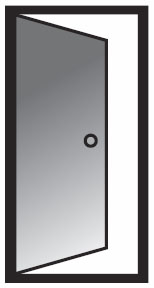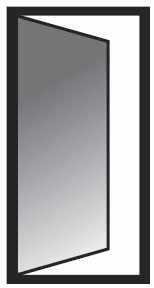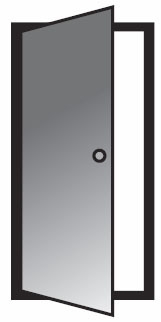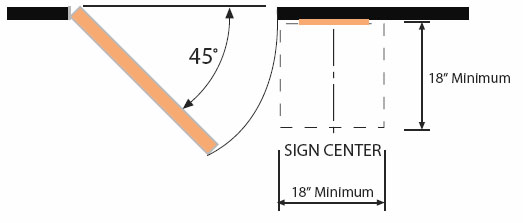The ADA (Americans with Disabilities Act) helps remove barriers for people with disabilities. More than 2.5 million Americans suffer from a visual impairment - not just blindness. High contrast ADA compliant signs help ensure accessibility for seniors, the visually impaired and blind.
An ADA compliant sign is required for every permanent room or space in a building. This document is designed to help you understand how ADA compliant signs should be installed. Always defer to your local building authority for regulations and code updates. You can review the guidelines enforceable as of March 15, 2016 at www.ada.gov - Chapter 7, section 703 of the ADA code relates to signs. Also checkout our compliance FAQs.
ADA Sign Mounting Height Requirements
The baseline of the tactile copy can be mounted between 48” at the lowest point to 60” at the highest point. This allows signs of different sizes to be mounted on the same visual plane.
Elevator cars are excluded from this rule.

ADA Sign Mounting Location
Signs should be mounted to the wall on the latch side of the door. If there is no room on that wall, the sign may be mounted on the nearest adjacent wall.

Single door: sign shall be mounted next to door on the latch side.

Double doors (two active leaves): Sign shall be located to the right of right handed door.

Double doors (one active leaf): Sign shall be located on inactive leaf.

Inward swinging doors: Sign may be mounted on door if three criteria are met: 1) the door closes automatically, 2) the sign is mounted on the push side of the door, 3) the door does not have a hold-open device. (Common examples of doors that meet these criteria are kitchen doors, rest room doors, etc).


Outward swinging doors: In the case of outward swinging doors, the sign must be mounted to the wall outside of the arc of the door swing. The sign should be located within an 18” x 18” square of clear !oor space (18” away from the door and 18” away from the wall). See diagram.
Overhead ADA Signs & Projecting ADA Signs
The bottom of overhead signage must be 80” above the floor.
Projecting wall mounted signs must be a minimum of 27” o" the !oor and have a maximum protrusion of 4” into a pathway.
Signs should not interfere with or block any door function, emergency equipment or sprinklers.

Frequently Asked Questions (FAQs)?
Q: Do all signs need to be ADA compliant and have Braille and tactile letters?
A: No, there are a number of signs that are not required to be ADA compliant. Building addresses, directories, parking signs and temporary signs don't need to be ADA compliant. Temporary signs are those used for 7 days or less.
Q: Do I need ADA compliant signs in the stairwells of my building?
A: You are required to have a tactile sign next to each door inside a stairwell. These signs should identify the foor level, stair level and exit level. Some local fire codes have size requirements for these signs. You should check with your local code authority.
Q: Who enforces ADA laws & requirements?
A: The Department of Justice has the ultimate responsibility for enforcing ADA laws. In practice, though, the actual assessment of signs is usually handled by local code inspectors. Citations from the Department of Justice can range as high as $50,000 for the first offence.
ADA Sign Installation Tips
Although signs can be installed at varying heights, we suggest installing all your signs at 54” from floor to the center of the sign.
Install signs with double sided tape by removing the tape backing. Then place the sign on a level and press it firmly in place against the wall.
Clear silicone should be added to the back of heavy or oversized signs.
ADA Sign Installation Guidelines & Requirements Download
You may also download a PDF version of this guide.
This document may be freely distributed.
